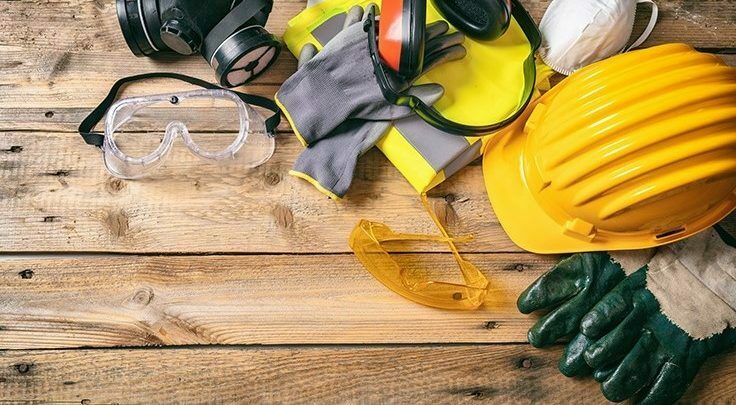
Safety at work and when doing jobs around the home is of paramount importance. As well as employing safe work practices, you need to make sure that you use relevant safety equipment. This includes wearing the right personal protective equipment for the task you’re tackling.
What is PPE?
Personal Protective Equipment, or PPE, refers to anything worn or otherwise used to minimise and mitigate risk to the health and safety of workers. It applies to a vast array of industries and there are various types of PPE to protect against falls to slips to drops to spills, and everything in between.
Just a few examples of PPE include:
- Face Shields or Masks – as worn by your dentist or surgeon
- Gloves – worn by medical staff or by industrial workers
- Goggles – worn by welders or lab technicians
- Gowns – worn by hospital staff
- Respirators – worn by firefighters or spray painters
- Helmets - worn by construction workers
- Safety harnesses – worn when working at height
- Hi-Vis Clothing – worn by traffic and road workers
- Safety Boots – worn where there is a risk of spills or dropped items
- Sunscreen and Hats – for those working outdoors
Why is PPE Important?
Safety is essential in the workplace and is a major issue for labourers, tradespeople, healthcare workers, scientists, and many others. Workplace (and home DIY) accidents and incidents happen frequently and in many cases could be prevented if appropriate PPE was used.
Australian Workplace Health and Safety laws and regulations require that risk management policies and practices be in place and that they are adhered to.
Using PPE is just one aspect of hazard control. It is intended to supplement safe work practices and it is used to minimise the risk of the activity to health and safety. It must:
- Be appropriate for the nature of the work and the hazard
- Be clean and hygienic
- Work properly to be effective
- Fit the user
- Be comfortable
- Not create a further hazard or impinge on the completion of tasks
Six Top Types of PPE
- Respiratory Protection – this is vital in workplaces or on jobs where there is potential exposure to toxic substances. Respirators are designed to protect workers from toxic fumes, dust (including asbestos and silica dust), pesticides, paint spray, and toxic smoke.
- Eye Protection – this includes safety goggles, safety glasses, and face shields, and protects the eyes (and sometimes also the face) in an array of industries. Some industries that require eye protection as the norm include woodworking, metalworking, working with air tools, and medical/science applications including surgery, dental work, lab work, blood collection, etc.
- Hearing Protection – industrial noise is a significant workplace hazard that can cause hearing loss many years after the exposure. This is especially common in the manufacturing and building sectors. Earmuffs (ideal for protection against high-frequency noise) and ear-plugs (ideal for reducing low-frequency noise) are important tools for hearing protection.
- Hand Protection – everyone from construction workers to industrial electricians to gardeners to medical and lab workers need protection for their hands in the form of gloves as suitable. These include rubber gloves, latex gloves, chainsaw gloves, heat-resistant gloves, and cut-resistant gloves. The right gloves for your application can help prevent burns, cuts, infection risk, and are essential if working with biohazards, chemicals, slippery items, hot items, sharp items, and electricity.
- Coveralls – these are all-in-one clothing items worn when dealing with hazardous materials and they provide protection for the entire body (except the face, hands, and feet) against contaminants such as asbestos, silica dust, and more. They are made from various materials depending resistant on their intended use, to be against everything from chemicals, sprays, liquids, abrasions, ignition, aerosol permeation, and more. They are often disposable.
- Safety Footwear – as important as any other form of PPE, protective footwear helps prevent injury due to slips, drops, spills, and more. It includes footwear with steel toe caps or that is waterproof - examples include safety Blundstone Boots and gumboots and these types of footwear provide protection from risks such as corrosive or chemical spills, dropped sharps, and slips in the workplace. Safety footwear is essential in many workplaces including construction, electrical, hospitals, food preparation, bar work, hairdressing, science labs, etc.
Head protection and sun protection (helmets, sun hats, sunscreen) are also essential as dictated by the work environment and associated risks.
Choose Southland Supply Group
Southland Supply Group is Australian-owned with warehouses in Sydney, Melbourne, Adelaide, Wagga & Canberra and our online store stocks and provides a vast array of thousands of products, including the ideal PPE for you to get the job done safely. We have been in this industry for more than thirty years and supply solutions Australia-wide. We are proud to carry large stocks at affordable prices, with customer-focused service and express delivery.
Whether you’re clearing asbestos, drilling and grinding metal, working outdoors under the hot Australian sun, or working in a lab or hospital where infection risk is high, and everything in between, we have the safety solutions you seek to ensure your safety and that of your workers. From orange safety gloves to Seabreeze hats to earmuffs and safety glasses, breathing apparatus to infection control coveralls and masks, we have it all.
Explore our website for PPE at https://www.southland.com.au/personal-protective-equipment or contact us today on 1800 77 22 91 or email webstore@southland.com.au
